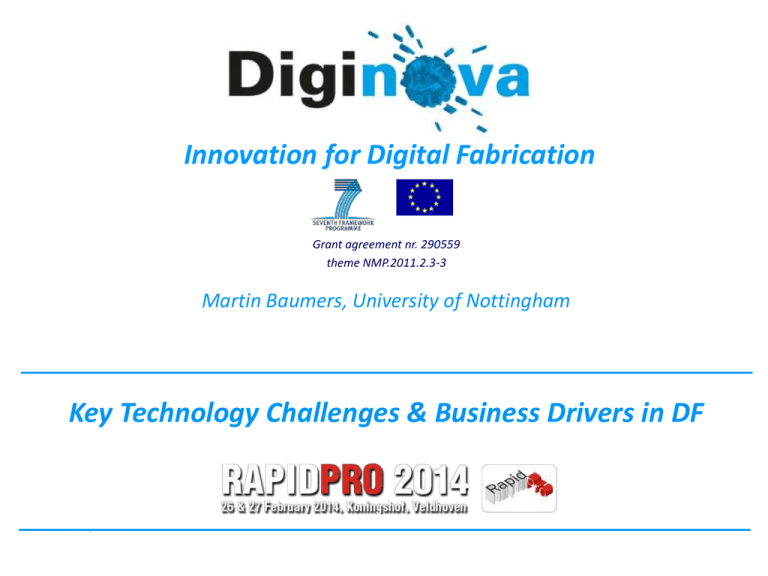Key Technology Challenges Business Drivers in DF
advertisement

Innovation for Digital Fabrication Grant agreement nr. 290559 theme NMP.2011.2.3-3 Martin Baumers, University of Nottingham Key Technology Challenges & Business Drivers in DF GA 290559 1 Overview Work package 4 In the Diginova project Participants & Methodology Business drivers Key technology challenges Research recommendations Summary GA 290559 2 Objectives of work package 4 Key technology challenges & business drivers Determine a methodology to identify and catalogue the Key Technology Challenges (KTCs) – both technological and business orientated Identify the Business Drivers towards Digital Fabrication, encompassing the full value chain. To inform the road mapping activity in work package 5 GA 290559 3 The partners in work package 4 Expertise concentrated in two distinct fields: 2D Digital Fabrication: Based on digital printing technology GA 290559 3D Digital Fabrication: Based on Additive Manufacturing 4 General apporach to the work Methodology based on Technology Innovation Needs Assessment (TINA) Successfully implemented for Additive Manufacturing (2012) Funded by the UK Technology Strategy Board GA 290559 5 Sequence of steps to identify key technology challenges and business dirvers Four-step approach (based on TINA) Recommendations for research Establishing baseline industry position and business drivers GA 290559 Identify barriers and technology challenges 6 Current state of Digital Fabrication Technology All data provided by the Diginova consortium and the group of stakeholders built through the project Current state of 2D and 3D digital fabrication technology: 2D: Identified 37 commercial systems and 14 developmental systems 3D: Identified 45 commercial systems and 11 developmental systems Identified technology classes: 2D • • • • • • • • • Piezoelectric inkjet Electrostatic inkjet Thermal inkjet Laser inkjet Indirect inkjet Continuous inkjet Electrophotography Aerosoljet Laser ablation technology GA 290559 • • • • • • • Powder bed fusion Directed energy deposition Material jetting Binder jetting Material extrusion Vat photopolymerisation Sheet lamination 3D 7 For which applications is Digital Fabrication currently used? Collected a wealth of data on which technologies are used for which applications Most of the data was entered in large tables Example: 3D printing technologies vs. applications GA 290559 8 Current state of technology usage: main results Two main results Data suggests that 2D digital fabrication is less widely adopted across applications than 3D digital fabrication 1. “Horses for courses” Possibly earlier stage on the technology diffusion curve for some technologies Note that these data are not a reflection of impact or economic value it is a reflection of diversity in applications Some technologies span different application families/domains 2. Piezoelectric jetting Aerosol jetting Powder bed fusion systems 3D technology variants appear to typically span more applications than 2D technologies GA 290559 9 Which business drivers are behind current technology usage? Various types of business drivers considered over the product life cycle: - Raw material - Raw material waste - Design freedom - Accuracy - Materials - Prod. economics - Energy & water - Lead time - IP protection GA 290559 - Short supply chains - Customisation - Decentralisation - (Multi)functionality - High performance - Graded materials - Recyclability 10 Data on business drivers Repeating methodology for technology usage, collected a wealth of data on which business drivers relate to which applications Entered in large tables, applications X-axis, drivers on Y-axis Example: 2D printing applications vs. drivers GA 290559 11 Business drivers of Digital Fabrication - Main observations “Fragmented” business drivers for 2D digital fabrication More uniform relevance of business drivers in application domains for 3D digital fabrication Independence of economies of scale is reported as a highly relevant business driver for both 2D and 3D Interestingly, economies of scale have also been described as a “stumbling block” in some industries (e.g. automotive) by a stakeholder GA 290559 12 Main observations for the business drivers of Digital Fabrication Other business drivers reported as important Supply chain consolidation and decentralisation (some 2D and some 3D) Design freedom and customisation (2D and 3D) Light weighting and optimisation (mainly 3D) Business drivers of smaller importance Raw material / substrate related End-of-life and recyclability GA 290559 13 Identification of Key Technology Challenges Identified barriers to technology diffusion 2D 3D • Relative process economics • Core system compatibility (incl. printhead-material) • Reliability, quality, robustness • Process architecture, openness • Jetting-head characteristics • Inter-system compatibility, modularity • • • • • • • • GA 290559 Relative process economics Productivity, capacity Reliability and quality Machine concept, openness of process architecture Ownership, liability, I.P., and standardisation Finance & skills base Design, tools and methods Acceptance in industry and society 14 Identification of Key Technology Challenges Identified Key technology challenges on the basis of barriers By pairing up the causes and possible solutions to each technology barrier Analyzed the comparative urgency of these barriers across 20 important application fields for Digital Fabrication, looking at: Digital Printing Additive Manufacturing Printed Electronics Human Applications GA 290559 15 Identified Key Technology Challenges and relative urgency GA 290559 16 Areas of technology challenges and technology convergence GA 290559 17 Making recommendations for research Addressing each Key Technology Challenge, a comprehensive list of research recommendations was created Separate recommendations for research for 2D and 3D Digital Fabrication technologies Contained in Diginova deliverable D4.3 “Report on sector based strategy for addressing challenges facing manufacturing” GA 290559 18 Summary Identified recommendations for research will be used to inform the European research agenda Also identifying gaps in EU industrial capability, i.e. technology integration Analysis of KTCs enables a prioritisation of research activities According to Diginova areas of high priority include: Process reliability, repeatability, material waste Process fundamentals and core system components Data handling and quality control methods Commercialisation agenda, education and legal framework GA 290559 19 Summary Currently observing the convergence of 2D digital printing and Additive Manufacturing Formation of a new field in manufacturing Diginova outputs have real novelty Numerous Key Technology Challenges must be addressed across all Technology Readiness Levels GA 290559 20 Thank You! GA 290559 21






